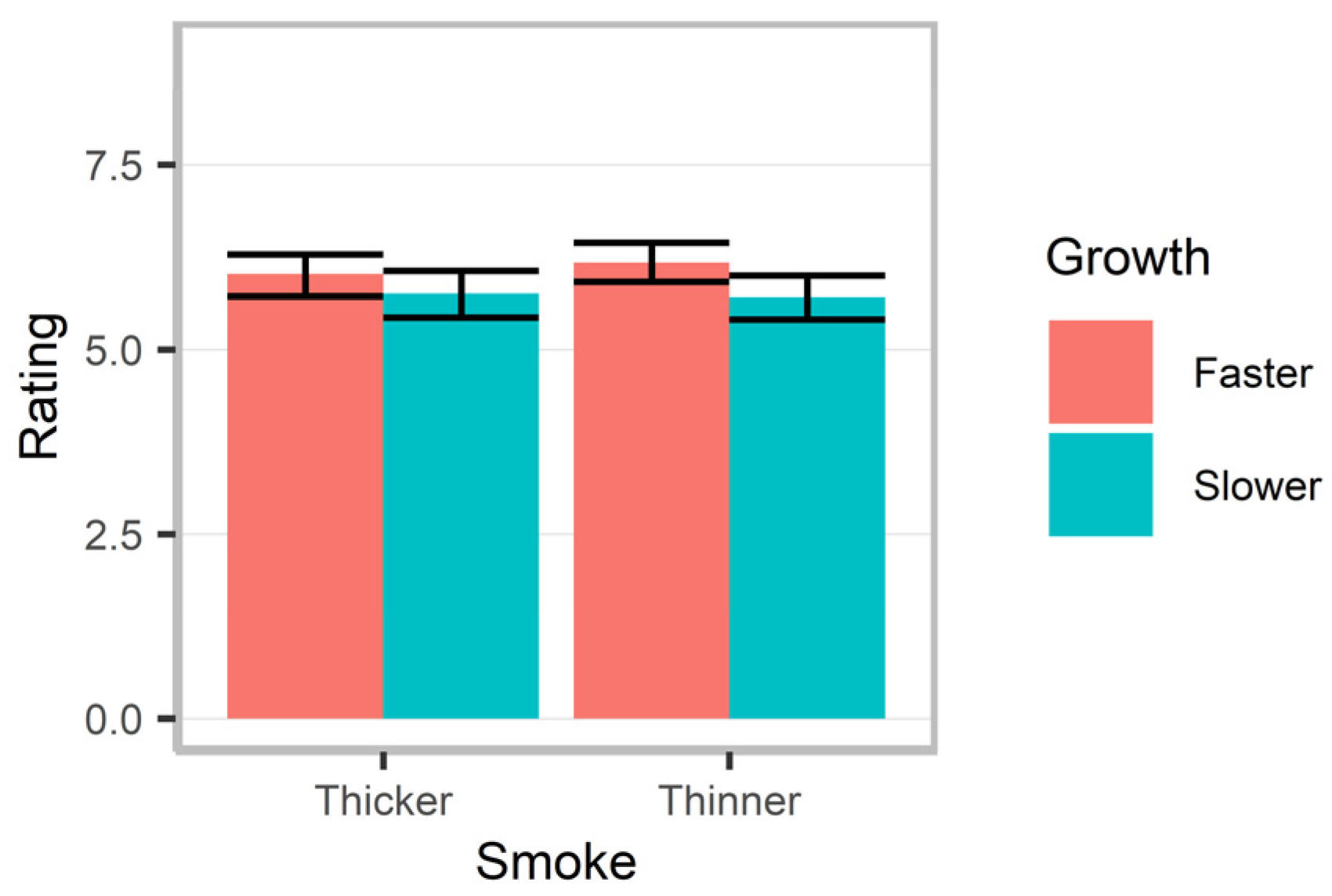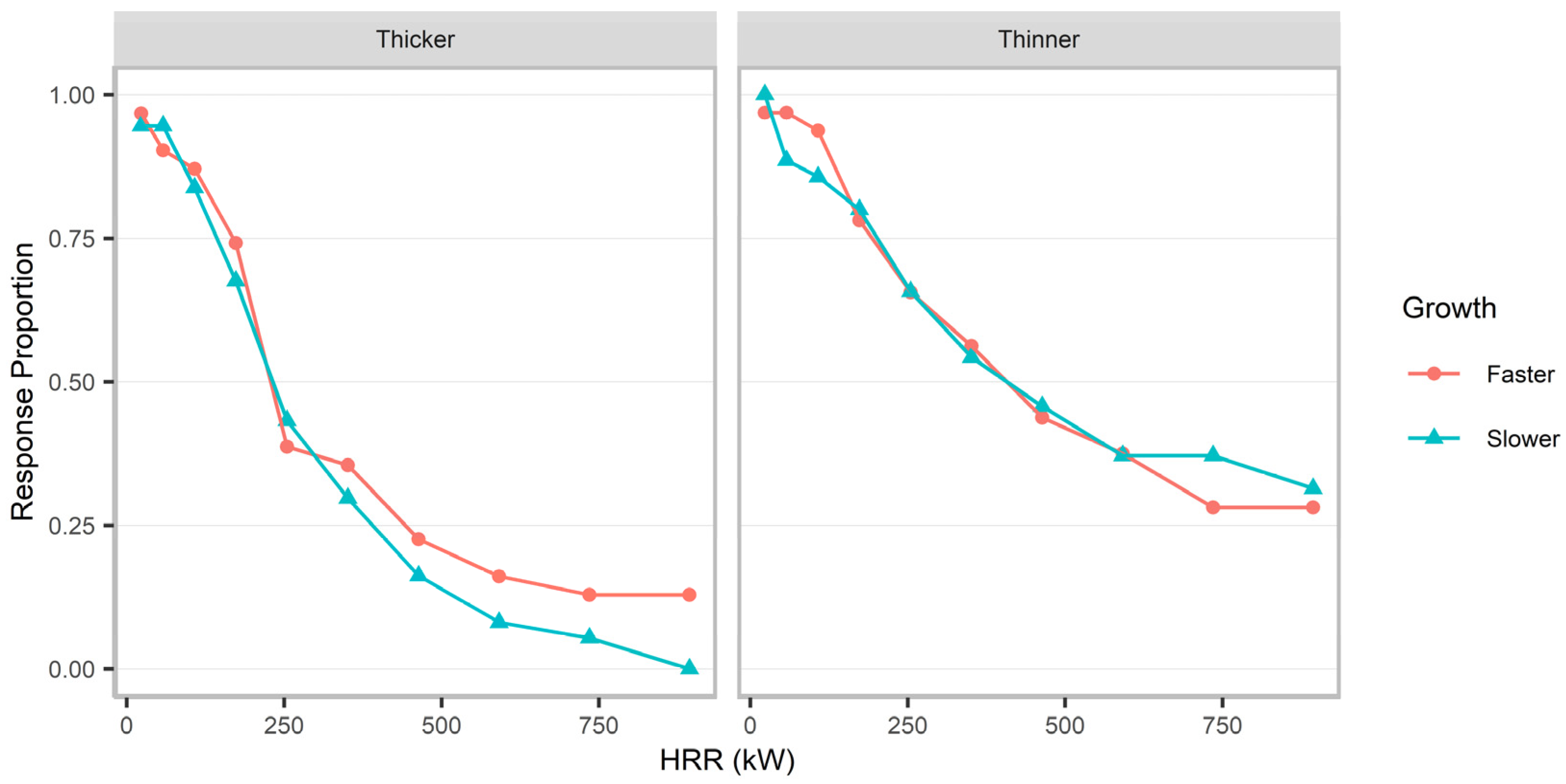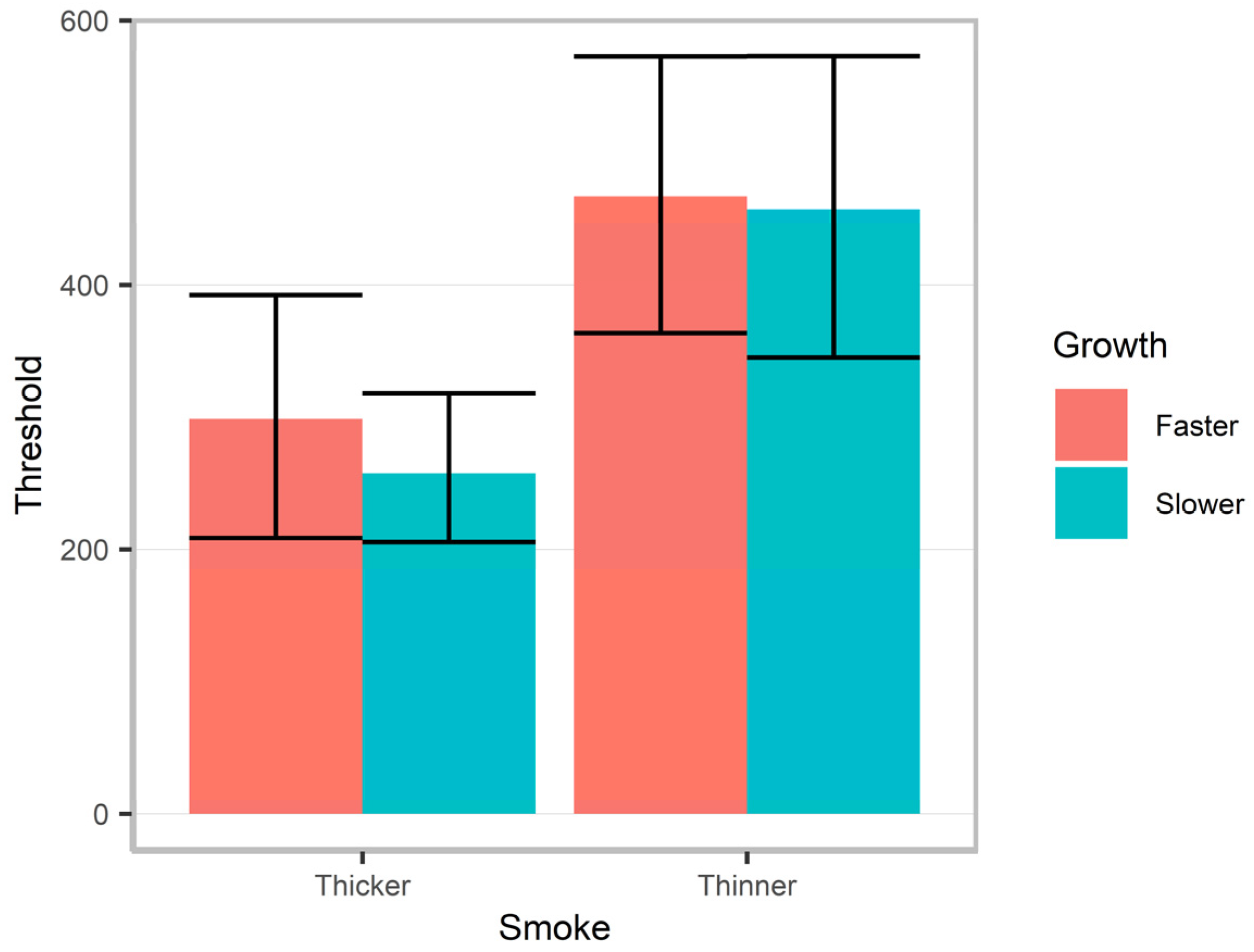Deciding Whether to Use a Fire Extinguisher: The Impact of Fire Intensity, Smoke, and Growth Rate
Abstract
1. Introduction
1.1. Fire Incidents Involving Extinguishers
1.2. Occupant Decisions During the Fire Extinguisher Lifecycle
1.3. When Should a Fire Extinguisher Be Used?
1.4. Impact of Fire Characteristics on Protective Action Decisions
1.5. Present Study
2. Materials and Methods
2.1. Participants
2.2. Materials
2.3. Experiment Design
2.4. Procedure
2.5. Measures
2.5.1. Perceived Risk
2.5.2. Response Choice
2.5.3. Extinguisher Threshold
3. Results
3.1. Analysis of Perceived Risk
3.2. Task Responses
4. Discussion
4.1. Fire Characteristics Impact Extinguisher Use
4.2. Effects of Fire Intensity and Smoke Thickness Align with Extinguisher Guidance
4.3. Future Directions and Limitations
5. Conclusions
Supplementary Materials
Author Contributions
Funding
Institutional Review Board Statement
Informed Consent Statement
Data Availability Statement
Acknowledgments
Conflicts of Interest
Abbreviations
| NFPA | National Fire Protection Association |
| UL | Underwriter Laboratories |
| HRR | Heat release rate |
| SD | Standard deviation |
| PADM | Protective action decision model |
References
- Kuligowski, E.D. The Process of Human Behavior in Fires; National Institute of Standards and Technology: Gaithersburg, MD, USA, 2009.
- Lovreglio, R.; Ronchi, E.; Nilsson, D. A Model of the Decision-Making Process during Pre-Evacuation. Fire Saf. J. 2015, 78, 168–179. [Google Scholar] [CrossRef]
- Arias, S.; Nilsson, D.; Wahlqvist, J. A Virtual Reality Study of Behavioral Sequences in Residential Fires. Fire Saf. J. 2021, 120, 103067. [Google Scholar] [CrossRef]
- Bryan, J.L. Smoke as a Determinant of Human Behavior in Fire Situations; U.S. Department of Commerce, National Bureau of Standards: Washington, DC, USA, 1977.
- Tong, D.; Canter, D. The Decision to Evacuate: A Study of the Motivations Which Contribute to Evacuation in the Event of Fire. Fire Saf. J. 1985, 9, 257–265. [Google Scholar] [CrossRef]
- Canter, D.; Breaux, J.; Sime, J. Domestic, Multiple Occupancy, and Hospital Fires. Fires Hum. Behav. 1980, 8, 117–136. [Google Scholar]
- Kinkel, E.; van der Wal, C.N.; Ronchi, E.; Kuligowski, E.D. Gaps in Human Behaviour in Fires Research: A Scoping Review. Fire Technol. 2025. [Google Scholar] [CrossRef]
- Lovreglio, R.; Duan, X.; Rahouti, A.; Phipps, R.; Nilsson, D. Comparing the Effectiveness of Fire Extinguisher Virtual Reality and Video Training. Virtual Real. 2021, 25, 133–145. [Google Scholar] [CrossRef]
- Bonny, J.W.; Russell, M.D. The Role of Suppression Performance Information in Judging When to Use a Fire Extinguisher. Safety 2025, 11, 58. [Google Scholar] [CrossRef]
- Greene, M.A.; Andres, C. 2004–2005 National Sample Survey of Unreported Residential Fires; U.S. Consumer Product Safety Commission: Washington, DC, USA, 2009.
- Gilbert, S. Human Behavior in Home Fires; National Institute of Standards and Technology: Gaithersburg, MD, USA, 2021.
- Poole, B.; Notarianni, K.A.; Harris, R.; Hicks, W.D.; Hanks, C.; Gorbett, G.E. Ordinary People and Effective Operation of Fire Extinguishers; Worcester Polytechnic Institute: Worcester, UK, 2012. [Google Scholar]
- Ramachandran, G.; Nash, P.; Benson, S.P. The Use of Fire Extinguishers in Dwellings; Fire Research Station: Borehamwood, UK, 1972. [Google Scholar]
- The Effectiveness of Portable Fire Extinguishers: An Overview 1976–2010; National Association of Fire Equipment Distributors: Chicago, IL, USA, 2010.
- Hall, S. Home Structure Fires; NFPA Research; National Fire Protection Association: Quincy, MA, USA, 2023. [Google Scholar]
- Hall, S.; McGree, T. Home Structure Fires; NFPA Research; National Fire Protection Association: Quincy, MA, USA, 2025. [Google Scholar]
- National Fire Protection Association. NFPA 10: Standard for Portable Fire Extinguishers, 2022 ed.; National Fire Protection Association: Quincy, MA, USA, 2022. [Google Scholar]
- Balint, S.; O’Donnell, R. Fire Extinguisher Training: Preparing Employees for a Fire Emergency. Prof. Saf. 2009, 54, 26–29. [Google Scholar]
- 2008 Portable Extinguisher Usage Report; Firewatch; National Association of Fire Equipment Distributors: Chicago, IL, USA, 2008.
- UL 711; Rating and Fire Testing of Fire Extinguishers. UL Standards & Engagement: Bensenville, IL, USA, 2023.
- 1910.157; Portable Fire Extinguishers. Occupational Safety and Health Administration (OSHA): Washington, DC, USA, 2024.
- Grosshandler, W. The Use of Portable Fire Extinguishers in Nightclubs: Workshop Summary; National Institute of Standards and Technology: Gaithersburg, MD, USA, 2007.
- City of Biddeford, Maine—Biddeford. Fire Department, Fire Extinguishers. Available online: https://www.biddefordmaine.org/2413/Fire-Extinguishers (accessed on 27 August 2025).
- Canadian Centre for Occupational Health and Safety (CCOHS). Fire Extinguishers-Portable. Available online: https://www.ccohs.ca/oshanswers/safety_haz/fire_extinguishers.html (accessed on 27 August 2025).
- U.S. Fire Administration (USFA). Choosing and Using Fire Extinguishers. Available online: https://www.usfa.fema.gov/prevention/home-fires/prepare-for-fire/fire-extinguishers/ (accessed on 25 January 2024).
- Kuligowski, E.D.; Mileti, D.S. Modeling Pre-Evacuation Delay by Occupants in World Trade Center Towers 1 and 2 on September 11, 2001. Fire Saf. J. 2009, 44, 487–496. [Google Scholar] [CrossRef]
- Hurley, M.J.; Gottuk, D.T.; Hall, J.R., Jr.; Harada, K.; Kuligowski, E.D.; Puchovsky, M.; Torero, J.L.; Watts, J.M., Jr.; Wieczorek, C.J. SFPE Handbook of Fire Protection Engineering; Springer: New York, NY, USA, 2015; ISBN 978-1-4939-2565-0. [Google Scholar]
- Wang, Y.; Kyriakidis, M.; Dang, V.N. Incorporating Human Factors in Emergency Evacuation–An Overview of Behavioral Factors and Models. Int. J. Disaster Risk Reduct. 2021, 60, 102254. [Google Scholar] [CrossRef]
- Kinateder, M.T.; Kuligowski, E.D.; Reneke, P.A.; Peacock, R.D. Risk Perception in Fire Evacuation Behavior Revisited: Definitions, Related Concepts, and Empirical Evidence. Fire Sci. Rev. 2015, 4, 1. [Google Scholar] [CrossRef] [PubMed]
- Reneke, P. Evacuation Decision Model (NIST IR 7914); Department of Commerce, National Institute of Standards and Technology (NIST): Gaithersburg, MD, USA, 2013.
- Kuligowski, E.D.; Gwynne, S.M.V.; Kinsey, M.J.; Hulse, L. Guidance for the Model User on Representing Human Behavior in Egress Models. Fire Technol. 2017, 53, 649–672. [Google Scholar] [CrossRef] [PubMed]
- Zhao, X.; Lovreglio, R.; Nilsson, D. Modelling and Interpreting Pre-Evacuation Decision-Making Using Machine Learning. Autom. Constr. 2020, 113, 103140. [Google Scholar] [CrossRef]
- Lovreglio, R.; Ronchi, E.; Nilsson, D. An Evacuation Decision Model Based on Perceived Risk, Social Influence and Behavioural Uncertainty. Simul. Model. Pract. Theory 2016, 66, 226–242. [Google Scholar] [CrossRef]
- Rodríguez, E.R.; Spearpoint, M. Assessment of the New Zealand Verification Method Pre-Travel Scenarios Using the Evacuation Decision Model. In Proceedings of the 6th International Symposium on Human Behaviour in Fire, Cambridge, UK, 28–30 September 2015; pp. 28–30. [Google Scholar]
- Bonny, J.W.; Milke, J.A. Precision of Visual Perception of Developing Fires. Fire 2023, 6, 328. [Google Scholar] [CrossRef]
- Bonny, J.W.; Hussain, Z.; Russell, M.D.; Trouve, A.C.; Milke, J.A. Simulated Fire Video Collection for Advancing Understanding of Human Behavior in Building Fires. Front. Psychol. 2024, 15, 1438020. [Google Scholar] [CrossRef]
- Russell, M.D.; Bonny, J.W.; Reed, R. Impact of Virtual Reality on Decision-Making and Risk Assessment During Simulated Residential Fire Scenarios. Fire 2024, 7, 427. [Google Scholar] [CrossRef]
- Ronchi, E.; Kapalo, K.; Bode, N.; Boyce, K.; Cuesta, A.; Feng, Y.; Galea, E.R.; Geoerg, P.; Gwynne, S.; Kennedy, E.B.; et al. Determinants of Gaps in Human Behaviour in Fire Research. Fire Technol. 2024. [Google Scholar] [CrossRef]
- Kidde Home Fire Extinguishers-Fire Extinguisher Ratings. Available online: https://www.kidde.com/home-safety/en/us/products/fire-safety/fire-extinguishers/for-home/ (accessed on 27 February 2023).
- Kim, H.-J.; Lilley, D.G. Heat Release Rates of Burning Items in Fires. J. Propuls. Power 2002, 18, 866–870. [Google Scholar] [CrossRef]
- Quintiere, J.G. Fundamentals of Fire Phenomena; Wiley: Hoboken, NJ, USA, 2006; ISBN 978-0-470-09113-5. [Google Scholar]
- Lenth, R.V.; Buerkner, P.; Herve, M.; Love, J.; Miguez, F.; Riebl, H.; Singmann, H. Emmeans: Estimated Marginal Means, Aka Least-Squares Means; The R Foundation: Vienna, Austria, 2022. [Google Scholar]
- Fox, J.; Weisberg, S. An R Companion to Applied Regression; Sage: Thousand Oaks, CA, USA, 2019; ISBN 978-1-5443-3647-3. [Google Scholar]
- Wickham, H. Ggplot2: Elegant Graphics for Data Analysis; Springer: Cham, Switzerland, 2016; ISBN 978-3-319-24277-4. [Google Scholar]
- Revelle, W. How to Do a Factor Analysis with the Psych Package; The Personality Project: Evanston, IL, USA, 2013; pp. 1–37. [Google Scholar]
- Brooks, M.E.; Kristensen, K.; Benthem, K.J.; van Magnusson, A.; Berg, C.W.; Nielsen, A.; Skaug, H.J.; Mächler, M.; Bolker, B.M. glmmTMB Balances Speed and Flexibility Among Packages for Zero-Inflated Generalized Linear Mixed Modeling. R J. 2017, 9, 378–400. [Google Scholar] [CrossRef]
- Venables, W.N.; Ripley, B.D. Modern Applied Statistics with S, 4th ed.; Springer: New York, NY, USA, 2002. [Google Scholar]
- Zeileis, A.; Hothorn, T. Diagnostic Checking in Regression Relationships. R News 2002, 2, 7–10. [Google Scholar]
- Zeileis, A.; Köll, S.; Graham, N. Various Versatile Variances: An Object-Oriented Implementation of Clustered Covariances in R. J. Stat. Softw. 2020, 95, 1–36. [Google Scholar] [CrossRef]
- Hulse, L.M.; Galea, E.R.; Thompson, O.F.; Wales, D. Perception and Recollection of Fire Hazards in Dwelling Fires. Saf. Sci. 2020, 122, 104518. [Google Scholar] [CrossRef]
- Yamada, T.; Akizuki, Y. Visibility and Human Behavior in Fire Smoke. In SFPE Handbook of Fire Protection Engineering; Hurley, M.J., Puchovsky, D.P., Eds.; Springer: Berlin/Heidelberg, Germany, 2016; pp. 2083–2110. [Google Scholar]
- National Fire Protection Association Fire Extinguishers 2025. Available online: https://www.nfpa.org/news-blogs-and-articles/blogs/2023/08/01/fire-extinguisher-types (accessed on 1 September 2025).
- Camerer, C.; Mobbs, D. Differences in Behavior and Brain Activity during Hypothetical and Real Choices. Trends Cogn. Sci. 2017, 21, 46–56. [Google Scholar] [CrossRef] [PubMed]
- Xu, S.; Pan, Y.; Wang, Y.; Spaeth, A.M.; Qu, Z.; Rao, H. Real and Hypothetical Monetary Rewards Modulate Risk Taking in the Brain. Sci. Rep. 2016, 6, 29520. [Google Scholar] [CrossRef]
- Poole, B.; Hicks, W.D.; Notarianni, K.A.; Hanks, C.; Harris, R.; Gorbett, G.E. Effective Use of Portable Fire Extinguishers by Ordinary People; Worcester Polytechnic Institute: Worcester, MA, USA; Eastern Kentucky University: Richmond, KY, USA, 2021. [Google Scholar]
- Shen, T.-S.; Huang, Y.-H.; Chien, S.-W. Using Fire Dynamic Simulation (FDS) to Reconstruct an Arson Fire Scene. Build. Environ. 2008, 43, 1036–1045. [Google Scholar] [CrossRef]




| Question | Never | Once | Several Times | Regularly |
|---|---|---|---|---|
| Have you ever been taught or trained in the use of a fire extinguisher? | 30 | 40 | 42 | 7 |
| Have you ever used fire extinguishers during training courses? | 50 | 32 | 34 | 3 |
| Have you ever used an extinguisher on a ‘real’ fire, outside of training? | 78 | 25 | 14 | 2 |
Disclaimer/Publisher’s Note: The statements, opinions and data contained in all publications are solely those of the individual author(s) and contributor(s) and not of MDPI and/or the editor(s). MDPI and/or the editor(s) disclaim responsibility for any injury to people or property resulting from any ideas, methods, instructions or products referred to in the content. |
© 2025 by the authors. Licensee MDPI, Basel, Switzerland. This article is an open access article distributed under the terms and conditions of the Creative Commons Attribution (CC BY) license (https://creativecommons.org/licenses/by/4.0/).
Share and Cite
Bonny, J.W.; Russell, M.D. Deciding Whether to Use a Fire Extinguisher: The Impact of Fire Intensity, Smoke, and Growth Rate. Fire 2025, 8, 386. https://doi.org/10.3390/fire8100386
Bonny JW, Russell MD. Deciding Whether to Use a Fire Extinguisher: The Impact of Fire Intensity, Smoke, and Growth Rate. Fire. 2025; 8(10):386. https://doi.org/10.3390/fire8100386
Chicago/Turabian StyleBonny, Justin W., and Micah D. Russell. 2025. "Deciding Whether to Use a Fire Extinguisher: The Impact of Fire Intensity, Smoke, and Growth Rate" Fire 8, no. 10: 386. https://doi.org/10.3390/fire8100386
APA StyleBonny, J. W., & Russell, M. D. (2025). Deciding Whether to Use a Fire Extinguisher: The Impact of Fire Intensity, Smoke, and Growth Rate. Fire, 8(10), 386. https://doi.org/10.3390/fire8100386





